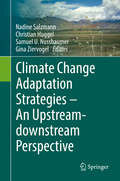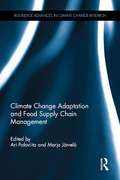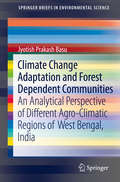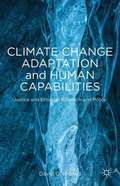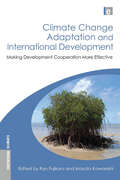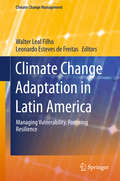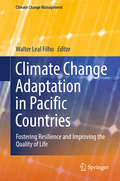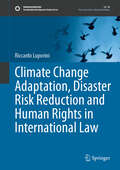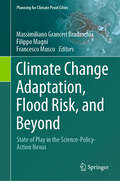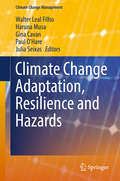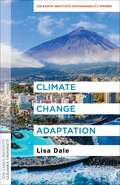- Table View
- List View
Climate Change Adaptation Measures in Vietnam: Development and Implementation (SpringerBriefs in Earth Sciences)
by Philipp Schmidt-Thomé Thi Ha Nguyen Thanh Long Pham Jaana Jarva Kristiina NuottimäkiThis book describes the iterative steps that were successfully undertaken to develop adaptation measures to climate change in two Vietnamese provinces. The methodology used to develop the scientific basis and the societal agreement of the need to adapt to climate change is applicable also to other regions in Vietnam, Asia and worldwide. The uncertainties of climate change models make it difficult to justify investments to finance protection from uncertain impacts. Setting out with the projected climate change impacts in Vietnam, which is one of the most vulnerable countries to climate change, the book describes a methodological approach to assess and evaluate local vulnerabilities of natural resources to climate change and socio-economic impacts, engaging local stakeholders in the development of locally acceptable and economically feasible adaptation measures. The methodological approach to understand the vulnerabilities and to develop climate change adaptation measures was scenario workshops that supported the communication between scientists and stakeholders. The development of climate change adaptation strategies is nearly state-of-the-art in many countries, but often there is still a large step towards implementing climate change adaptation measures on the local level. The challenge in the development of adaptation measures lies in their acceptability by local stakeholders and decision makers. Climate change adaptation measures also usually demand investments. To understand potential future risks the communication methodology was to first get a good understanding of the natural resources (mainly surface and groundwater) and their potential vulnerabilities (current and future). This was followed by developing a common understanding of current risk patterns, as well as underlying vulnerabilities and hazards. Socio-economic developments have an equally strong, and in the short term mostly even stronger, impact on the living environment and natural resources as long-term climate change impacts. The scenario workshops developed a holistic approach on current and potential future risk patterns, with a special focus on surface and groundwater quantities and qualities, natural hazards and sea level rise. Land-use planning was identified as playing a decisive role in minimizing current and future risks. Finally, first adaptation measures for two Vietnamese provinces were developed and shall be implemented over the next years. The methodology that led to these adaptation measures shall be applied in other Vietnamese provinces.
Climate Change Adaptation Strategies – An Upstream-downstream Perspective: An Upstream-downstream Perspective
by Christian Huggel Nadine Salzmann Samuel U. Nussbaumer Gina ZiervogelClimate change and the related adverse impacts are among the greatest challenges facing humankind during the coming decades. Even with a significant reduction of anthropogenic greenhouse gas emissions, it will be inevitable for societies to adapt to new climatic conditions and associated impacts and risks. This book offers insights to first experiences of developing and implementing adaptation measures, with a particular focus on mountain environments and the adjacent downstream areas. It provides a comprehensive 'state-of-the-art' of climate change adaptation in these areas through the collection and evaluation of knowledge from several local and regional case studies and by offering new expertise and insights at the global level. As such, the book is an important source for scientists, practitioners and decision makers alike, who are working in the field of climate change adaptation and towards sustainable development in the sense of the Paris Agreement and the Agenda 2030.
Climate Change Adaptation and Development
by John CarstensenClimate change is real and it is man-made. We have put so many greenhouse gas pollutants into the atmosphere that we will see significant and long-term change that we need to adapt and adjust to. It is important for development practitioners to understand these impacts and the challenge of how and when to adapt to climate change.There are plenty of grim presentations of what the extremes of the possible climate scenarios will throw at us over the next 100 years, but not all change will be disastrous; some change will be beneficial, but much of the change will happen at an unprecedented rate that will require the best possible analysis and understanding of how and when we should adapt to climate change.This is important for development practitioners as we invest in ensuring that poverty is reduced and eliminated and the well-being of everyone is improved. Many countries and communities around the world are vulnerable to the impacts of climate change, but developing economies may on one hand be less resilient to the impact, but could on the other hand be in a better position to make their development climate smart by making the most efficient use of their economic resources.The chapters in this book shine a light on the complexity and the multi-dimensional aspects of climate change adaptation. They gather some of the experiences of addressing climate change impacts in a development context. This book was previously published as a special issue of Development in Practice.
Climate Change Adaptation and Development: Transforming Paradigms and Practices (Climate And Development Ser.)
by Karen O'Brien Tor Håkon Inderberg Siri Eriksen Linda SygnaClimate change poses multiple challenges to development. It affects lives and livelihoods, infrastructure and institutions, as well as beliefs, cultures and identities. There is a growing recognition that the social dimensions of vulnerability and adaptation now need to move to the forefront of development policies and practices. This book presents case studies showing that climate change is as much a problem of development as for development, with many of the risks closely linked to past, present and future development pathways. Development policies and practices can play a key role in addressing climate change, but it is critical to question to what extent such actions and interventions reproduce, rather than address, the social and political structures and development pathways driving vulnerability. The chapters emphasise that adaptation is about much more than a set of projects or interventions to reduce specific impacts of climate change; it is about living with change while also transforming the processes that contribute to vulnerability in the first place. This book will help students in the field of climate change and development to make sense of adaptation as a social process, and it will provide practitioners, policymakers and researchers working at the interface between climate change and development with useful insights for approaching adaptation as part of a larger transformation to sustainability.
Climate Change Adaptation and Food Supply Chain Management (Routledge Advances in Climate Change Research)
by Marja Järvelä Ari PaloviitaThe success of the entire food supply chain depends on the prosperity of farms and local communities. The direct climate change risks faced by the agricultural sector are therefore also risks to businesses and food supply chains. Hence the importance of resilience at farm level, community level and business level when looking at food supply chain policy and management. Climate Change Adaptation and Food Supply Chain Management highlights the issue of adaptation to climate change in food supply chains, the management and policy implications and the importance of supply chain resilience. Attention is given to each phase of the supply chain: input production, agriculture, food processing, retailing, consumption and post-consumption. European case studies demonstrate the vulnerabilities of contemporary food supply chains, the opportunities and competitive advantages related to climate change, and the trans-disciplinary challenges related to successful climate adaptation. The authors argue for a redefinition of the way food supply chains are operated, located and coordinated and propose a novel approach enhancing climate-resilient food supply chain policy and management. This book will be of interest to students, researchers, practitioners and policymakers in the field of climate adaptation and food supply chain management and policy.
Climate Change Adaptation and Forest Dependent Communities: An Analytical Perspective of Different Agro-Climatic Regions of West Bengal, India (SpringerBriefs in Environmental Science)
by Jyotish Prakash BasuThis book addresses the livelihood impacts of climate change, vulnerability and adaptation measures on the forest dependent communities of India. Research presented here focuses on three different agro-climatic areas of West Bengal, namely the coastal Sundarban, the drought-prone region and the mountainous region. Readers will discover the main climate induced vulnerabilities that affect livelihoods of forest communities, understand how to evaluate the expected impacts of climate change at different levels under different climate change scenarios, and be able to assess and measure the implied major social, environmental and economic impacts. Particular attention is also given to the role of the Indian governmental policy (including national forest policy of 1988) to reduce climate-related vulnerabilities. Chapters also highlight two main approaches to vulnerability assessment in socio-ecological systems. The first is the impact-based approach, which assesses the potential impacts of climate change on forest dependent people. The second is the vulnerability-based approach, which assesses social sensitivity and adaptive capacity to respond to stresses. Development practitioners, government implementing agencies, and researchers in environmental science and policy will find this book appealing.
Climate Change Adaptation and Green Finance: The Arctic and Non-Arctic World (Routledge Advances in Climate Change Research)
by Gisele Arruda Lara JohannsdottirThis book presents specific case studies of climate finance in the Arctic and examines how the green revolution could be a game changer in this sensitive region. Bringing together contributions from a range of experts in the field, Climate Change Adaptation and Green Finance assesses the costs of inaction versus the costs of action based on case study examples of climate finance and sustainable investment in the Arctic region. The authors draw on data from the Sixth Assessment Report published by the Intergovernmental Panel on Climate Change and respond with a solutions-based framework. This is developed around the notion of a new, carbon-neutral economy in the Arctic and presents methods for unlocking carbon finance and long-term climate investment in the region, such as finance for Arctic entrepreneurs and resilient sustainable investment structures. This volume also looks at the role of finance in meeting the United Nations Sustainable Development Goals and the ways in which innovation in investment will help shape the future of the Arctic. Climate Change Adaptation and Green Finance will be of great interest to students and scholars of climate change, sustainable finance and sustainable business
Climate Change Adaptation and Green Finance: The Arctic and Non-Arctic World (Routledge Advances in Climate Change Research)
by Gisele Arruda Lara JohannsdottirThis book presents specific case studies of climate finance in the Arctic and examines how the green revolution could be a game changer in this sensitive region.Bringing together contributions from a range of experts in the field, Climate Change Adaptation and Green Finance assesses the costs of inaction versus the costs of action based on case study examples of climate finance and sustainable investment in the Arctic region. The authors draw on data from the Sixth Assessment Report published by the Intergovernmental Panel on Climate Change and respond with a solutions-based framework. This is developed around the notion of a new, carbon-neutral economy in the Arctic and presents methods for unlocking carbon finance and long-term climate investment in the region, such as finance for Arctic entrepreneurs and resilient sustainable investment structures. This volume also looks at the role of finance in meeting the United Nations Sustainable Development Goals and the ways in which innovation in investment will help shape the future of the Arctic. Climate Change Adaptation and Green Finance will be of great interest to students and scholars of climate change, sustainable finance, and sustainable business.
Climate Change Adaptation and Human Capabilities
by David O. KronlidClimate Change Adaptation and Human Capabilities explores learning, health, mobility, and play as climate capabilities and produces new insights into the depth of climate change impact on social life.
Climate Change Adaptation and International Development: Making Development Cooperation More Effective
by Masato Kawanishi Ryo FujikuraClimate change impacts upon the world's poorest most heavily. It is therefore essential that international development initiatives focus on improving the ability of developing countries to adapt to the effects of climate change. This book, a product of research by the JICA-RI (Research Institute of the Japan International Cooperation Agency), examines climate change adaptation from the perspective of development cooperation in order to provide useful lessons for those engaged in research, policy and practice in this vital area. In this book the editors have brought together a wide range of case studies from across Africa and Asia, covering urban and rural areas and different sectors including water, agriculture and disaster management, in order to examine the following: o high-resolution climate change projection in Asia and how this can be used in planning appropriate adaptation responses o in-depth case studies of climate change projections, social, economic and environmental impact and vulnerability assessment and adaptation in rural Thailand and urban Philippines o cases across Africa for which climate data is less readily available and alternative approaches need to be adopted o the current situation amongst international donors o emerging issues caused by climate change In the introductory section, the editors draw together the full implications from the case studies to discuss how international communities can support adaptation in developing countries and to give an assessment of bilateral projects. They reflect on the lessons learned and offer recommendations for future research and international development cooperation.
Climate Change Adaptation in Africa: An Historical Ecology (Routledge Advances in Climate Change Research)
by Gufu ObaIn the context of growing global concerns about climate change, this book presents a regional and sub-continental synthesis of pastoralists' responses to past environmental changes and reflects on the lessons for current and future environmental challenges. Drawing from rock art, archaeology, paleoecological data, trade, ancient hydrological technology, vegetation, social memory and historical documentation, this book creates detailed reconstructions of past climate change adaptations across Sahelian Africa. It evaluates the present and future challenges to climate change adaptation in the region in terms of social memory, rainfall variability, environmental change and armed conflicts and examines the ways in which governance and policy drivers may undermine pastoralists’ adaptive strategies. The book’s scope covers the Red Sea coast, Somaliland, Somalia, the Ogaden region of Ethiopia, and northern Kenya, part of the Ethiopian highlands and Eritrea, areas where past climate change has been extreme and future change makes it vital to understand the dynamics of adaptation. This book will be of interest to students and scholars of environmental history, human ecology, geography, climate change, environment studies, development studies, pastoralism, anthropology and African studies.
Climate Change Adaptation in Africa: Fostering Resilience and Capacity to Adapt (Climate Change Management)
by Walter Leal Filho Simane Belay Jokasha Kalangu Wuta Menas Pantaleo Munishi Kumbirai MusiyiwaThis collection showcases experiences from research and field projects in climate change adaptation on the African continent. It includes a set of papers presented at a symposium held in Addis Abeba in February 2016, which brought together international experts to discuss "fostering African resilience and capacity to adapt. " The papers introduce a wide range of methodological approaches and practical case studies to show how climate change adaptation can be implemented in regions and countries across the continent. Responding to the need for more cross-sectoral interaction among the various stakeholders working in the field of climate change adaptation, the book fosters the exchange of information on best practices across the African continent.
Climate Change Adaptation in Developed Nations: From Theory to Practice (Advances in Global Change Research #42)
by James D. Ford Lea Berrang-FordIt is now widely accepted that adaptation will be necessary if we are to manage the risks posed by climate change. What we know about adaptation, however, is limited. While there is a well established body of scholarship proposing assessment approaches and explaining concepts, few studies have examined if and how adaptation is taking place at a national or regional level.
Climate Change Adaptation in Eastern Europe: Managing Risks And Building Resilience To Climate Change (Climate Change Management Ser.)
by Walter Leal Filho Dejan Filipovic Goran TrbicThis book focuses on managing risks and building resilience to climate change, showcasing experiences from research, field projects and best practices to foster climate change adaptation in Eastern Europe that can be implemented elsewhere.Climate change affects countries in Eastern Europe, i.e. the Western Balkans and Southeast Europe in a variety of ways. Apart from severe floods, there are reports of decreasing water reserves in the southern regions, and of gradual changes in biodiversity and agricultural production. In the South Caucasus area, for instance, climate change models project a decline in precipitation and suggest that it will continue to become drier this century.Many Eastern European countries, especially the non-EU ones, have weak national climate policies, and transboundary collaborations, as well as limited public engagement in matters related to climate change. As a result, climate change poses a serious threat to their economic stability and development and to the sustainable development of the region.The above state of affairs illustrates the need for a better understanding of how climate change influences Eastern Europe, and for the identification of processes, methods and tools that may help the countries and the communities in the region to adapt. There is also a perceived need to showcase successful examples of how to cope with the social, economic and political problems posed by floods/droughts in the region, especially ways of increasing the resilience of agriculture systems and of communities.Addressing this need, the book presents papers written by scholars, social practitioners and members of government agencies involved in research and/or climate change projects in Eastern Europe.
Climate Change Adaptation in Latin America: Managing Vulnerability, Fostering Resilience (Climate Change Management)
by Walter Leal Filho Leonardo Esteves de FreitasThis book showcases experiences from research, field projects and best practice in climate change adaptation in countries in the Latin American region, focusing on managing vulnerability and fostering resilience. It includes a selection of papers presented at a specialist symposium on climate change adaptation held in Rio de Janeiro, Brazil in November 2016. Consistent with the need for more cross-sectoral interaction among the various stakeholders working in the field of climate change adaptation in Latin America, the book documents and disseminates the wealth of experiences in the region. It is divided into two main parts: Part 1 addresses the current and future impacts of climate change on fauna, flora and landscapes, while Part 2 is concerned with the socio-economic aspects of climate change adaptation, analyzing some of the main problems prevailing in this vulnerable region and examining ways to address them.
Climate Change Adaptation in Pacific Countries: Fostering Resilience and Improving the Quality of Life (Climate Change Management)
by Walter Leal FilhoThis book showcases vital lessons learned from research, field projects and best practice examples with regard to climate change adaptation in countries throughout the Pacific region, a part of the planet that is particularly vulnerable to and affected by climate change. The book's primary goals are to document the wealth of experiences in the region available today, to encourage cross-sector interactions among the various stakeholders in the region, and to help transfer results to other countries and regions. Accordingly, it gathers a set of papers presented at a symposium on climate change adaptation held in Fiji in July 2016, focusing on "Fostering Resilience and Improving the Quality of Life". In these contributions, local and international experts present a variety of initiatives showing how Pacific countries are coping with the many problems associated with climate change, including initiatives in education and awareness work taking place across the region, operational aspects and their implications for policy-making, and challenges in urban and rural areas.
Climate Change Adaptation in Practice
by Johannes Klein Philipp Schmidt-ThomeClimate change adaptation is increasingly recognized as complementary part to climate change mitigation. Climate change affects sea level, the extent of flood prone areas and precipitation patterns among many others. To adapt to these changes, the tasks of municipalities and cities are to implement policies and strategies for changes in land use and coastal management as part of their future development. It is of vital importance to address the uncertainties of climate change scenarios when proposing adaptation measures that are socially viable and economically reasonable. The decision making process, promoted here, is based on scientific excellence as well on an integrated communication process.This book provides a comprehensive overview of key elements required for effective analysis and assessment of climate change impacts, economic cost-benefit analysis, communication processes and creation and transfer of knowledge, governance issues and implementation of related policies. It describes the results achieved by the BaltCICA (www.baltcica.org) project whose contributors come from the scientific and public administration communities. The regional cooperation has led to the implementation of climate change adaptation in several case studies. The BaltCICA project developed concepts, methodologies and tools for climate change adaptation that can be translated across other global regions. Scientists and students working on the development of climate change and adaptation strategies; public administrators in the related fields on local, regional and state level including environment, water management, civil defense; as well as professionals working with adaptation technologies, including engineering, technological solutions, urban planning agencies and construction, will value this innovative book.
Climate Change Adaptation in River Management: A Comparative Study of Germany and South Korea (Palgrave Studies in Water Governance: Policy and Practice)
by Yi hyun KangThis book examines the approaches to climate change adaptation in water governance taken by South Korea and Germany. By comparing their political decision-making processes, this book explores the factors behind their differences. Adaptation to the changing climate is critical to human society and water is the principal medium through which climate change will affect us. Due to high levels of industrialization and population density, flood control is a high priority in both countries’ adaptation plans. While South Korea has maintained its engineering-oriented flood control policy for river management, Germany has turned its direction from its long-standing technical approach to more nature-based solutions. The evidence of this study indicates that policy change and stability is the result of discourse and institutional interaction, and thus emphasizes the validity of discursive institutionalism. This book will clearly explain why certain policies are adopted for water management and will be an invaluable contribution to the expanding literature on the socio-political aspects of climate change adaptation.
Climate Change Adaptation in Southeast Asia (Disaster Risk Reduction)
by Rajib Shaw Joy Jacqueline Pereira Mohd Khairul ZainThis book highlights the current issues, challenges, and priorities for climate change adaptation in the ten member states of the Association of Southeast Asian Nations (ASEAN). The status of each country was prepared by a consortium of researchers in consultation with National Focal Points of the ASEAN Working Group on Climate Change (AWGCC). National documents on adaptation actions, including local scenario and priorities, were reviewed where available and supplemented with an assessment of scientific publications to identify vulnerable ecosystems and regions. Adaptation needs and priorities were determined through stakeholder consultation in the respective countries. This allows for local-level perspectives to be captured and brought to the attention of policy and decision-makers at the national and regional levels. An important lesson from this exercise is that universities and research institutions at the national level have a critical role to play in bridging the gap between science and policy in climate change adaptation. These institutions also have the capacity to continuously facilitate transfer of the best available science for advancing climate change adaptation at the local level.
Climate Change Adaptation in the Built Environment: Transdisciplinary and Innovative Learning
by Dilanthi Amaratunga Richard Haigh Mo Hamza Chamindi Malalgoda Shavindree Nissanka Nishara Fernando Ruben Paul BorgGlobal climate change is one of the greatest environmental threats facing humanity and it is affecting every country on every continent. Recent evidence confirms a close liaison between climate change induced hazards and the built environment, as the built environment demonstrates a high fragility and vulnerability to hazardous situations. The impact of climate change is particularly pertinent to the built environment given the life expectancy of buildings and the fact that it is essential to adapt the existing built environment to deal with a climate that may be significantly different from that in which it evolved. Coastal regions are highly vulnerable to climate change because, in addition to changes in temperature, precipitation, and more frequent flooding, they will be affected by rising sea levels, wave heights, and accelerated coastal erosion. The built environment exerts considerable influence over coastal communities' local climate and environment. Coastal areas also tend to be highly populated, with many vulnerable urban centres located near the coastal belt. In addressing such challenges, it is important to better understand the impacts of climate change on the built environment and to develop tangible climate adaptation measures for the built environment.
Climate Change Adaptation, Disaster Risk Reduction and Human Rights in International Law (Sustainable Development Goals Series)
by Riccardo LuporiniClimate change poses an escalating challenge to global society, with climate-related disasters becoming more frequent, severe and widespread in their impact on individuals and communities, and in their interference with human rights. To confront this challenge, States must not only mitigate climate change by reducing greenhouse gas emissions but also adopt comprehensive measures to adapt to its effects and manage climate change-related disaster risk. This book provides an in-depth analysis of the international legal frameworks governing climate change adaptation and disaster risk reduction, focusing on the critical role of human rights in strengthening these frameworks and ensuring their implementation. The study explores the extent to which human rights have been integrated into international climate change and disaster law, examines how climate change-related disaster risk is addressed within international human rights law, and assesses the growing trend of human rights-based climate change and disaster litigation and its potential regulatory impact. The book offers a unique perspective on international lawmaking in the fields of climate change and disaster management while also shedding light on the ongoing development of human rights law as it seeks to address the unprecedented threats posed by climate change and its associated risks.
Climate Change Adaptation, Flood Risk, and Beyond: State of Play in the Science-Policy-Action Nexus (Planning for Climate Proof Cities)
by Francesco Musco Massimiliano Granceri Bradaschia Filippo MagniThis book includes the insights of a seminar that was held at IUAV University of Venice, on May 29th and 30th featuring 10 speakers. 8 speakers, 2 moderators, and 1 organizer from the seminar, plus 10 other authors contributed to this book. The writers’ expertise spans from local climate adaptation planning, public policy analysis, climate and environmental finance, and climate adaptation advocacy to multi-risk analysis, GIS, disaster risk management, ecosystem services assessment, urban geography, art, and civic engagement. The book contents address adaptation and flood risk mitigation along the Science-Policy-Action path - both theoretical and operative perspectives are discussed. EU climate adaptation policy and finance, climate adaptation implementation, flood risk analysis, nature-based solutions, blue ecosystem services, regional adaptation planning, and critical infrastructure adaptation are the topics investigated in depth by the writers.
Climate Change Adaptation, Governance and New Issues of Value: Measuring the Impact of ESG Scores on CoE and Firm Performance (Palgrave Studies in Impact Finance)
by Carlo Bellavite Pellegrini Laura Pellegrini Massimo CatizoneThis book investigates sustainability, CSR, climate change adaptation, the relevance of ESG scores and their impact on firm value and growth. The first part of the book analyses the topics from a conceptual angle. The authors discuss how the concepts of self-consciousness and awareness drive the shift of the traditional concept of corporate mission towards more sustainable business models. The authors propose an in-depth analysis of the main challenges posed by climate change and of the initial policy-makers’ responses and provide their view on the central role of ESG scores and circular economy for growth and development. The authors conclude with an analysis of the main literature on the measurement of the relation between ESG scores and firms’ performance and cost of equity (CoE). The second part of the book contains comparative empirical evidence, supporting these theories across specific industries, and will be of interest to academics, researchers, and students of sustainability and impact finance.
Climate Change Adaptation, Resilience and Hazards (Climate Change Management)
by Walter Leal Filho Haruna Musa Gina Cavan Paul O'Hare Julia SeixasThis book analyses the links between climate change adaptation, resilience and the impacts of hazards. The contributors cover topics such as climate change adaptation in coastal zones, the evaluation of community land models, climate change considerations in public health and water resource management, as well as conceptual frameworks for understanding vulnerabilities to extreme climate events. The book focuses on a variety of concrete projects, initiatives and strategies currently being implemented across the world. It also presents case studies, trends, data and projects that illustrate how cities, communities and regions have been striving to achieve resilience and have handled hazards.
Climate Change Adaptation: An Earth Institute Sustainability Primer (Columbia University Earth Institute Sustainability Primers)
by Lisa DaleClimate change policy has typically emphasized mitigation, calling for reducing emissions and shifting away from fossil fuels. Yet while these efforts have floundered, floods, wildfires, droughts, and other disasters are becoming more frequent and potent. As the risks escalate, we must ask how to adapt to a changing climate. How might farmers modify their practices to maximize food security? Can coastal cities protect their infrastructure from rising seas? Are there strategic ways for developing countries to combine climate resilience with economic growth and poverty reduction? For people and societies around the world, these questions are not theoretical: adaptation is already underway.This book offers a concise overview of climate adaptation governance. In clear, accessible language, Lisa Dale describes key strategies that governments, communities, and the private sector are now deploying. She presents the theory and practice that underlie climate adaptation efforts at local and global scales, providing illuminating case studies that foreground the problems facing developing countries. Dale analyzes the effectiveness of a range of policy interventions, drawing out principles of good governance and discussing how practitioners can navigate complex tradeoffs. She emphasizes equity and inclusion, considering how climate adaptation policy can account for the needs of historically disadvantaged groups. Written for a wide audience, this book is an invaluable introduction for all readers interested in how societies can meet the challenges of an altered climate.

